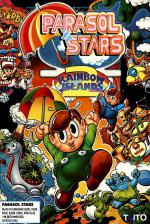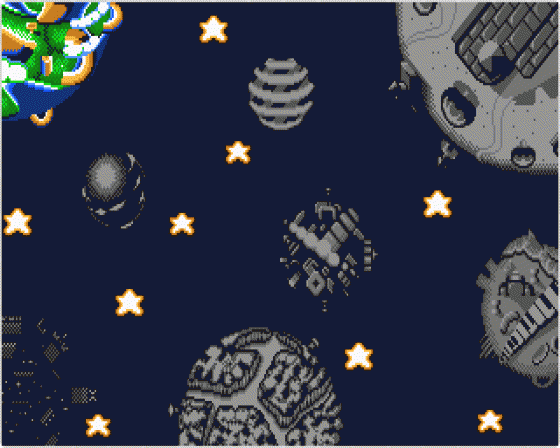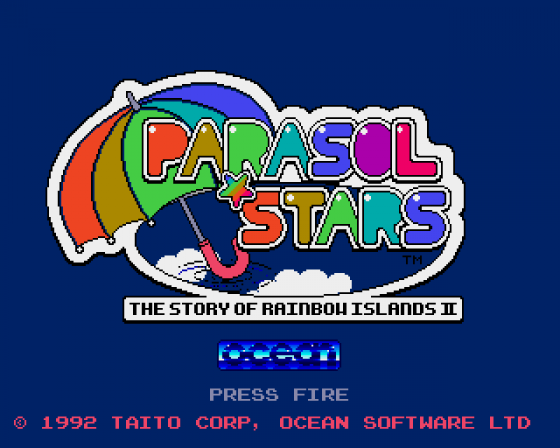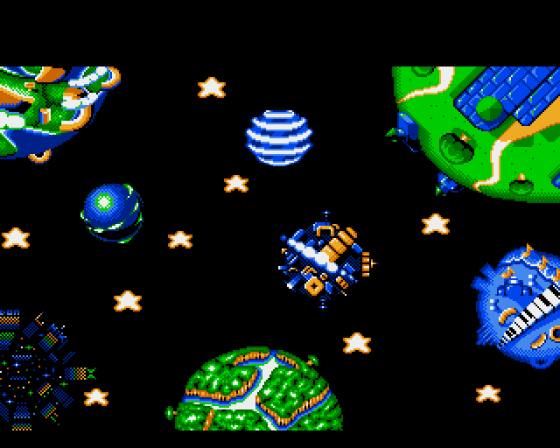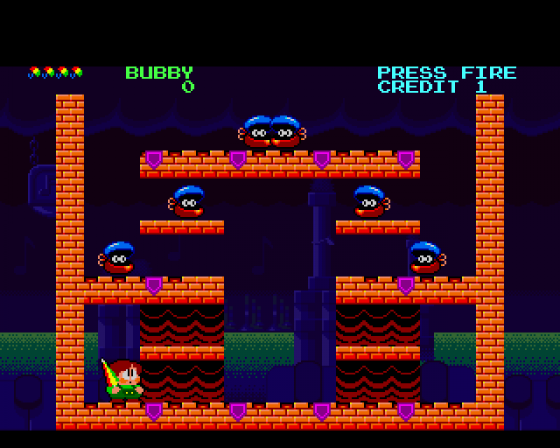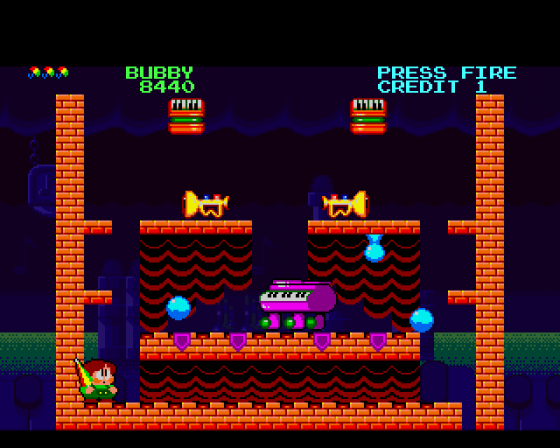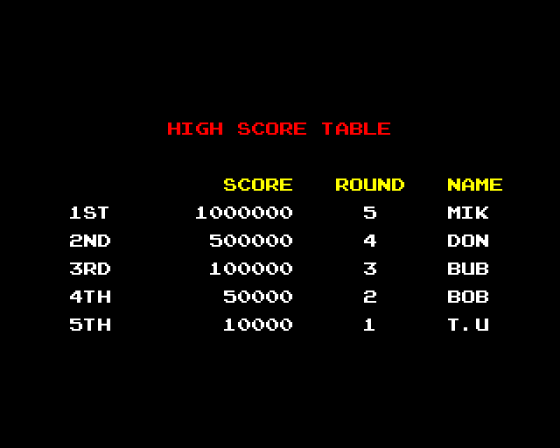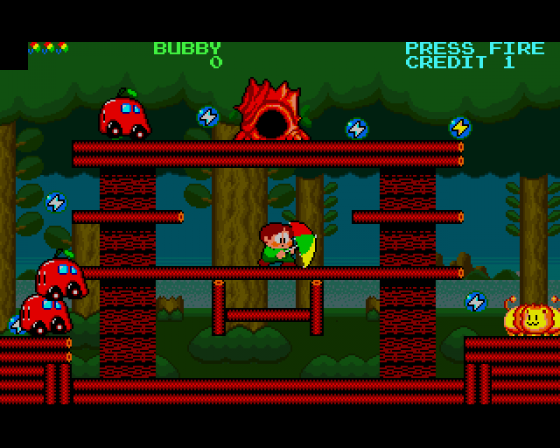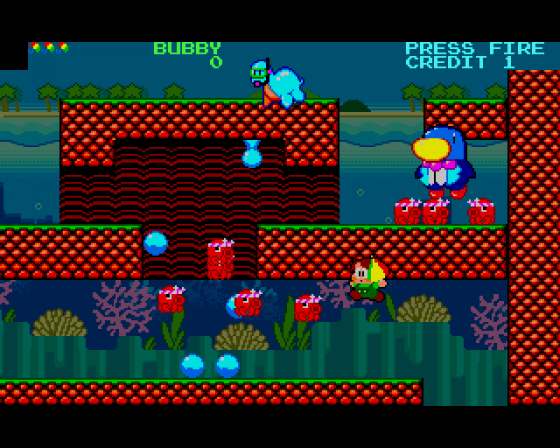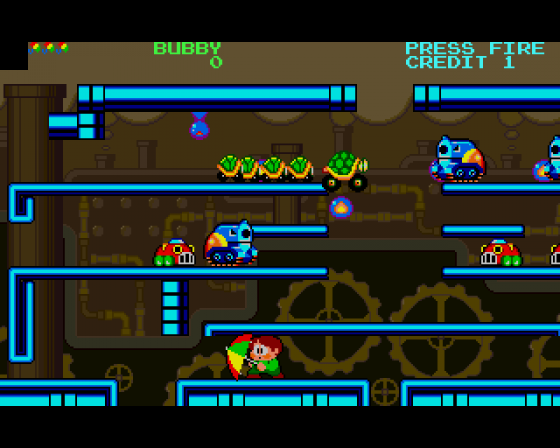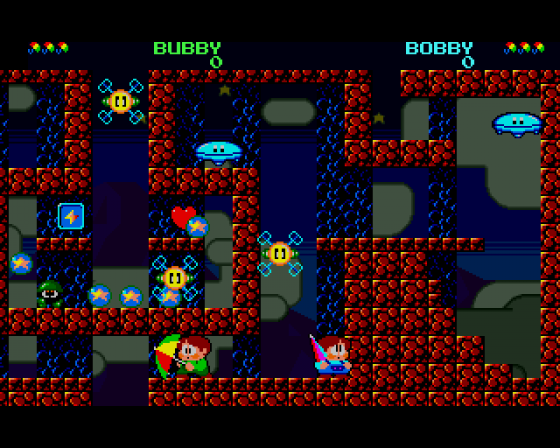
Future Publishing
 7th February 1992
7th February 1992
Categories: Review: Software
Author: Jim Douglas
Publisher: Taito
Machine: Amiga 500
Published in Ace #055: April 1992
Parasol Stars
Over the next month or so, the right-thinking sensibilities of the games buying public will be assaulted in a most insidious and distressing manner. Thousands and thousands of words will drone on about about how funny and fluffy and zany the game they call Parasol Stars is, and what a kooky and kerrazy milestone in gaming history it represents. But let's not kid ourselves. It's just another bleeding platform game with useless animation, isn't it?
It's tricky to cite a more sickening example of a game designer's imagination gone mad than Bub and Bob, "heroes" of the Bubble Bobble series. With their big, rolling eyes and their dungarees, their stupid little puckered lips and their silly red hair, they make the most nauseating duo since The Krankies.
The theory that such undiluted Japaneseyness may prove a little exotic for the Western palette is borne out by the fact that the previous Bub and Bob coin-ops (Bubble Bobble and Rainbow Islands) have consistently fared worse than even the most tired arcade shoot-'em-ups.
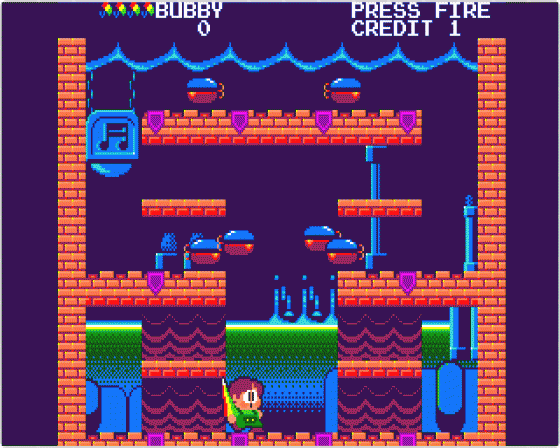
The adventures of the loathsome twosome have fared considerably better on home formats, however, with Firebird and Ocean enjoying much chart-topping success with Bubble Bobble and Rainbow Islands respectively. Maybe playing with two fat little cherubs is acceptable in the privacy of one's own home.
And, let's face it, once you've grown to accept the graphic style, which is not entirely dissimilar to a nasty acid trip and come to terms with the unusual gameplay, the series provides amusement which, if nothing else, isn't really available elsewhere.
The first outing of the series, Bubble Bobble, had - for no good reason - our two heroes transformed into brontosauruses for the duration of the game. The aim was to rid each screen of baddies by ensnaring them in bubbles and then bursting the bubbles to collect bonus fruit. Many professed Bubble Bobble was a bit of a breakthrough and marked the return to good old-fashioned games-playing values. Others pointed out that, despite its enjoyable two-player angle, it had atrocious graphics and never really progressed, simply becoming harder and harder, and leaving the player thoroughly unsatisfied.
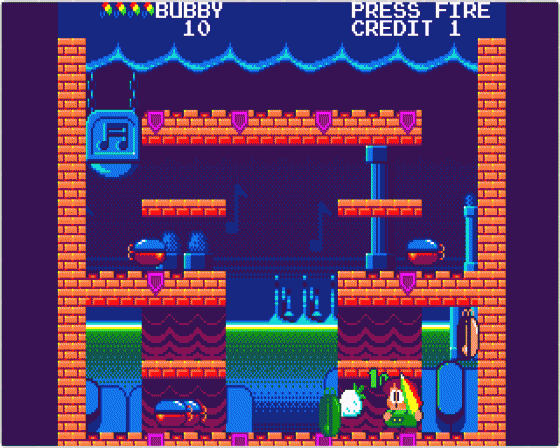
Rainbow Islands, however, was a marked improvement. Back in their human form, Bub and Bub were challenged with restoring colour to a suite of islands robbed of hue by the Prince of Darkness. This was a far more enjoyable affair, with Bub and Bob armed with magic abilities enabling them to form solid rainbows at will. The rainbows could be used both to capture baddies and climb up the screens, making for a rather pleasing visual experience. The downside here, however, was that there was no simultaneous two-player mode.
So the fact that Parasol Stars promises to be a blend of both Bubble Bobble and Rainbow Islands makes it an intriguing prospect, if nothing else.
The common thread running through all of Bub and Bob's adventures is the collection of secret bonuses. Throwing captured monsters into certain areas of the screen will reveal points or fruit. Performing other permutations of moves with the fruit will yield yet more points. However, points are not vital to the completion of each level: they're just there for the player who wants to explore. It's probably this factor more than any other which turned off potential coin-op players. Once your cash is ticking away, the tendency (certainly amongst goal-driven British players) is to complete each screen. We generally don't have the patience to explore levels we've already finished.

As a result, lots of Brits simply couldn't really see the point. When playing the game in a home environment, however, there's more incentive to understand the game dynamics and find those hidden extras.
And there's hidden extras aplenty in Parasol Stars. Hidden doors lead through to bonus worlds. Hidden switches reveal previously invisible lines of fruit. And it's all there to be discovered for the player with the inclination to look.
In their bid to remove the mad warrior Chaostikahn and his menacing monsters from the universe, Bub and Bob must visit eight plants; destroying enemies peculiar to each and thus restoring colour and happiness. Each planet is broken down into seven levels, with the obligatory end-of-world guardian marauding around the final screen.

And with what fearsome weapons from the Bubble arsenal have Bub and Bob been equipped? A pair of parasols, of course. While they may be weedy little bits of bloth that turn inside out with the slightest gust here on Earth, they're pretty handy in the further flung areas of the universe. The parasols are used in two distinct ways. The first is simply to shield the player from monsters. Holding the joystick down and pressing fire will raise the parasol, offering protection from an assault from above. Pressing fire while the joystick points in another direction will bring on an enemy-swiping flourish.
The second method involves more patience but can produce devastating results. Throughout most screens, magic droplets drip from the ceilings. The droplets can be caught on the parasol and then fired off left or right, allowing the player to pick off enemies at a distance. Alternatively, the player can build up a store of up to five droplets and then use them to unleash a massive bolt of baddie-bashing energy, taking the form of waterfall or enormous lightning bolt depending on the form of droplets being used.
Compare And Contrast
A three-way Compare And Contrast this time. Rainbow Islands was far the more popular of the Bub and Bob games, even though it didn't boast the excellent two-player japes available in Bubble Bobble. So what elements the two may have made it through to Parasol Stars? The crazy scoring system is still the same, with multiple bonuses, etc.

But the rainbows are gone. Instead, Bub and Bob use their brollies in much the same way as they blew bubbles in the first game. And the goal of reaching the top of the screen in Rainbow Islands has been replaced by a more straightforward (and in my opinion less rewarding) aim of clearing the screen of baddies.
Parasol Stars may well win the day in your opinion, but Rainbow Islands still snatches it for me.
So, with parasols in their hands and goodness in their hearts, Bub and Bob travel to mission one; Music World. While the baddies are different for each world, the pattern of events is largely the same. That is; Bub and Bob fly in on their parasols and sit in the bottom corners of the screen. Monsters will then explode out from a central position on the screen into their appropriate start positions. In the first world, of course, everything has a musical theme.
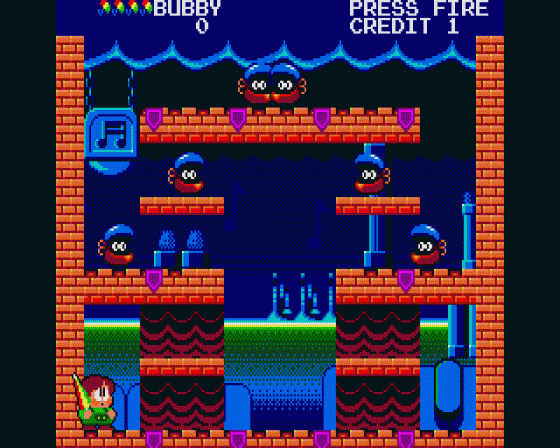
As explained earlier, actually completing most of the screens isn't particularly difficult. Instead it's completing the screens well and exposing and collecting the myriad of secret bonuses which is where the real skill lies.
The scoring system seems rather complicated at first, but has a logical foundation. Each bit of fruit lying around on the level will score between ten and 10,000 points. The big fruits will all score 100,000. In order for the player to earn points from baddie-bashing alone, the monsters need to be thrown against each other when they are paralysed (indicated by them becoming green or blue). 2,000 points are awarded for the first monster destroyed this way, and then 4,000, 8,000 and so on, doubling right up to 100,000 if the player manages to destroy an entire line of seven or more monsters in one go. Extra credits can also be obtained by collecting the 100 coin.
Like Bubble Bobble, Parasol Stars works best as a two player game. Even on the earlier levels which are filled with relatively feeble bad guys, life is a whole lot easier when the players are working well together. At the end of some levels, when the guardians become really difficult, a solo battle is not really worth considering.

But there is a price to pay for teaming up. Receiving a hit from a stray droplet or even a careless flurry of a parasol will result in either Bub or Bob being flung across the screen. Often this will result in a number of monsters being bashed of bonuses being revealed. Devious players can, of course, fling their companion around intentionally, but shouldn't expect much co-operation when it comes to the end of the level.
Each stage is effectively "cleared" once all the monsters have been knocked off. The players then have a limited amount of time to clear up any straggling bits of fruit before they are returned to their bottom-corner positions and whisked away in a rather jarring scroll to the next stage.
And so it goes on until seven stages have been completed and the players prepare to do battle with the obligatory end-of-world fiend.
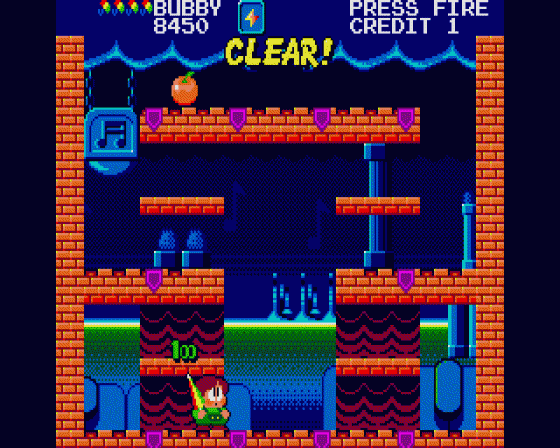
It's here that Parasol Stars makes one of its slips. Some of the end-of-world guardians, especially the girl being drawn along in a carriage by a demented My Little Pony lookalike take so many hits before they will finally go away that the only real facet of the player's ability being tested is his patience.
A limited number of continues are available, but using one in the midst of a battle with the guardians will replenish half of the guardian's strength. The best policy by far is to do battle with the guardians for as long as one player can hold out and then for whichever player is left to continue the fight alone.
The eventual vanquishing of the guardian will result in a cut back to the view of all the worlds, with a miniature Bub and Bob swooshing away from the recently coloured world off to another grey one. It's a shame that the worlds have to be completed in a particular order, and there's no option to select the one the player fancies next, but there you go. Another omission is a password system. Once the game is over, there's no way to skip through to the stage last attained. Instead, every level must be played again. Players will have to decide for themselves how appealling a pospect this is.
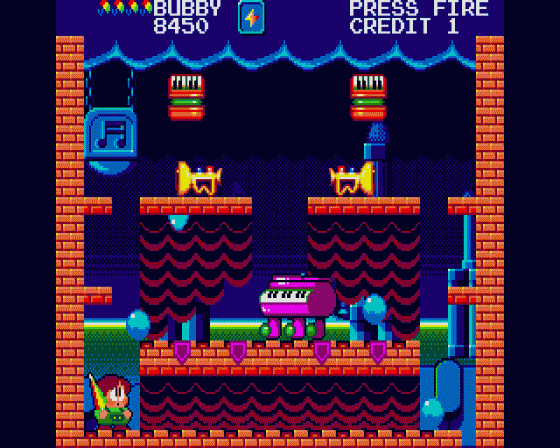
Graphically, Parasol Stars is a paradox. Stationary, it looks like an absolute dream, with beautifully coloured monsters sitting menacingly atop their ledges and pieces of fruit glinting appetisingly in the far reaches of the screen. However, when it all moves, it's another matter. The variety and richness of the colours become an assault on the senses and the volume of objects needing animation pares the frames for each right down. Although many hundred times better than Bubble Bobble, Parasol Stars is still a long way short of perfect.
Of the previous two titles, Parasol Stars is probably closer to Bubble Bobble. As a two-player game it works well, but solo it doesn't. The graphics are a lot better, but the game really isn't about the way it looks. There are lots of worlds to complete, but the game is more about amassing scores than finishing levels. However, the Bubble Bobble series is nothing if not original, and there's enough of a learning curve for the player to scale simply to fully understand how to control Bub and Bob properly and work out the rules of their environment to make it an amusing though complicated affair.
It certainly isn't a game for all tastes, and players used to or fond of games where the difficulty is more evenly paced and the eventual score doesn't really matter would be well advised to consider the outlay carefully. However, fans of the series and in particular those players lucky enough to have played the PC Engine version will know exactly what to expect, and won't be disappointed. And I'm sure such folks will be only too pleased to discover that players heroic enough to reach the rather excellent end sequence will receive an invitation to "Watch out for Bubble Bobble IV!". Yum.
Listen, Do You Want To Know A Secret?

Secrets, eh? They're what life is all about. Those precious little nuggets of information known only to a select few people. What a delicious position to hold - the owner of a secret.
By this token, the folks up at Ocean are in a doubly super situation, knowing where two completely so-secret-if-you-didn't-know-where-to-look-you'd-miss-them worlds can be found in the game that they are already calling "Parasol Stars". The worlds can be accessed from within other worlds by simply falling through secret doors. Revealing the doors, of course, is another matter. The first world takes the form of a true nostalgia trip, whoosing the players back to Bubble Bobble land where they can play a miniature version of the heroes' very first outing.
The second - the Most Secret World - is one constructed entirely from the minds of the roistering boys at Ocean, and incorporates all their favourite elements of the Bub and Bob phenomenon.
Amiga Version

No surprises here. The graphics are colourful and the action is fast and frenetic. However, Parasol Stars has a peculiar graphic style. All thoughts of the player's poor little eyes seem to have been set aside in the name of more and more colours. The animations of the monsters spinning around once they've been bashed is also a bit limited, probably owing to the huge variety necessary. In all, it's a game you need to make allowances for.
ST Version
Not quite as smooth and boasting slightly fewer colours, the ST version of Bubble Bobble may find it tough to reconcile the failings inherent in the original game when disarmed of the Amiga's best features; lots of speed and colour. Watch the pinks for a final verdict.
PC Version
Alas and alack. Bub and Bob will be blowing no bubbles on the IBM. Boo.
Uppers
- Very colourful.
- Lots of levels.
- Good team-up option.
Downers
- Solo play is a bit of a waste of time.
- Very tough.
- In motion, it looks like an explosion in a Fuzzy Felt factory.
Verdict
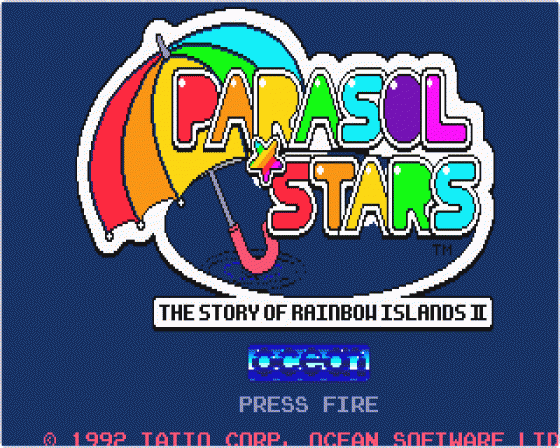
Phew! Here's an up and downer if ever there was one. Initial excitement is provided, largely, by the anticipation of playing a game of which the player really hasn't a clue what to expect.
After play of about an hour, however, the novelty has worn off somewhat and it becomes clear that some careful attention to scoring platforms and a dedicated search for secret rooms is necessary in order to extract the most fun from the game.
Whether the player has the inclination to play in such a vigorous manner is, I suspect, a matter of personal taste.
Other Reviews Of Parasol Stars For The Amiga 500
Parasol Stars (Ocean)
A review by Stuart Campbell (Amiga Power)
Parasol Stars (Taito)
Once again, that lovable twosome, Bub and Bob, are back for plenty of madcap platform action. And this time they've even got some protection if it starts raining.
Scores
Atari ST Version| Overall | 85% |
Scores
Amiga 500 Version| Overall | 85% |

